
FEBRUARY 2023 • Vol. 11 • No.02 (ISSN 2564-1956) 16 HR ManageMent tips FoR sMall Business owneRs - Brett Farmiloe, CEO/CHRO, Terkel.io 19 14 25 32 practical HR tips For small Business owners - Jessica Lambrecht, The Rise Journey Five trends that will shape HR in 2023 - Jacky Turnbull, Topia six HR transformations For 2023 - Jamie Aitken, Betterworks the Future of HR is Being Forged now - John Doel, KPMG LLP
17 Workplace 3.0: How Leaders Should Prepare For The Newest Office Evolution
Transforming from status quo to supercharged
- Brigette McInnis-Day, Chief People Officer, UiPath
16 HR Management tips For small Business owners

From creating a checklist to outsourcing HR, the list continues
- Brett Farmiloe, CEO/CHRO, Terkel.io
22 Why Should HR Integrate L&D Into Their Talent Management Strategy?
Never underestimate the value of retaining top talent
- Laura Baldwin, President, O’Reilly Media
30 What Meeting Data Tells Us About Hybrid Work Culture
Implementing “meeting-free” days has been successful for many organizations
- Mike Tolliver, Product Management Director, Vyopta
36 Major Trends Impacting People Management In 2023

The best people operations teams in the world run like product management functions
- Finn Bartram, Editor in Chief, People Managing People
07 in D e X
HR Strategy & Planning Excellence FEBRUARY 2023 Vol.11 No.02 (ISSN 2564-1956)
On the Cover
Articles
Practical HR Tips For Small Business Owners

Hiring and retention best practices business owners can implement to build diverse teams and create an inclusive workplace
- Jessica Lambrecht, Co-Founder and CEO, The Rise Journey
Five Trends That Will Shape HR In 2023


From distributed work to employee retention
- Jacky Turnbull, Chief People Officer, Topia
Six HR Transformations For 2023
What’s the wisest way to approach transformation?
- Jamie Aitken, VP, HR Transformation, Betterworks
Top Picks 14 19 25 32
The Future Of HR Is Being Forged Now
HR leaders can help their companies move past the flux of the pandemic to a future of genuine flow
 - John Doel, Advisory Principal, KPMG LLP
- John Doel, Advisory Principal, KPMG LLP
INDEX
How are our HR Strategy & Planning Products and Ser vices helping to make you smar ter?
HR Strategy & Planning Excellence - Monthly Interactive Learning Journal
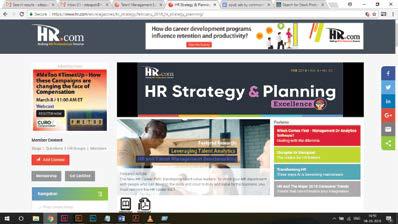
This monthly interactive learning experience captures key metrics and actionable items and keeps you focused on your HR strategy and planning goals and solutions.
HR Strategy and Planning Vir tual Events

In HR Strategy and Planning events, discover the business process for ensuring that an organization has suitable access to talent to ensure future business success, trends in strategic planning and analytics, resource requests, analyzing resource utilization, forecasting capacity, and managing human resources. The learning experience offered teaches how to capture key metrics and actionable items and keep you focused on your HR strategy and planning goals and solutions and make them impactful. Each Vir tual Event consists of up to 10 credit webcasts.
HR Strategy and Planning Webcasts for Credit
HR.com webcasts deliver the latest HR Strategy and Planning industry news, research trends, best practices and case studies directly to your desktop. Webcasts are available live online with a downloadable podcast and a copy of the slides (PDF) available before and after each
HR.com’s one-hour webcasts, in every HR specialty including HRIS and Payroll, are pre-approved for HRCI and SHRM credit (excluding Demo webcasts).
HR Strategy and Planning Community
Join almost 70,000 HR.com members with a similar interest and focus on workforce planning and analytics. Share content and download reserach repor ts, blogs, and ar ticles, network, and “follow” peers and have them “follow” you in a social network platform to communicate regularly and stay on top of the latest updates. This well established Workforce Planning and Analytics Community is an invaluable resource for any HR professional or manager Use
these invaluable HR Strategy & Planning resources today! For more information phone: 1.877.472.6648 | email: sales@hr.com | www.hr.com
Editorial Purpose
Our mission is to promote personal and professional development based on constructive values, sound ethics, and timeless principles.
Excellence Publications
Debbie McGrath CEO, HR.com - Publisher
Sue Kelley Director (Product, Marketing, and Research)
Babitha Balakrishnan and Deepa Damodaran Excellence Publications Managers and Editors
HR Strategy & Planning Excellence (ISSN 2564-1956)
Babitha Balakrishnan Editor
Chinnavel Design and Layout (Digital Magazine)
Vibha Kini Magazine (Online Version)
Submissions & Correspondence
Please send any correspondence, articles, letters to the editor, and requests to reprint, republish, or excerpt articles to ePubEditors@hr.com.
For customer service, or information on products and services, call 1-877-472-6648
sales@hr.com
Internet Address: www.hr.com
Debbie Mcgrath Publisher, HR.com
credited.
Babitha Balakrishnan Editor, HR Strategy & Planning Excellence

why HR is important for Business success
Withan abrupt shift to remote work, mass resignations, and economic volatility, the HR department has been challenged across the board.
With workers today demanding flexible working opportunities, learning paths and competitive compensation and benefits, HR is under pressure to keep up with balancing internal and external challenges and knowing how to prioritize budgets and resources. Undoubtedly, HR functions have to stay one step ahead of these challenges to attract, retain, and provide compelling reasons to consider their organizations.
However, a small business may look at HR and its role from a completely different perspective compared to a big organization. Are there any HR best practices for small businesses? What trends will shape HR in 2023? How to execute a successful HR transformation? Learn the answers to these questions and more in the February edition of HR Strategy & Planning Excellence.
Interested in learning how can small business owners successfully delegate HR?

Brett Farmiloe (CEO/CHRO, Terkel.io) in his article, 16 HR Management Tips For Small Business Owners, lists effective tips shared by small business owners that includes creating a checklist to outsourcing HR.
Jessica Lambrecht’s (Co-Founder and CEO, The Rise Journey) article, Practical HR Tips For Small Business Owners also shares steps small business owners can take today to make immediate improvements to their existing systems to increase the quality of their talent pipeline and create an inclusive workplace where employees will flourish.
The year 2023 will bring its own challenges in the form of high inflation, a cost-of-living crisis, and looming economic uncertainty. And it is not going to be a smooth ride ahead for HR. What does the future hold for HR? Read Jacky Turnbull’s (Chief People Officer, Topia) article, Five Trends That Will Shape HR In 2023, for valuable insights on this topic.
To keep pace with the disruptive changes today, HR must transform, and the wisest way to approach transformation is to map the current and future states of the company and adjust HR operations suitably, according to Jamie Aitken (VP, HR Transformation, Betterworks) in her article, Six HR Transformations For 2023.
As John Doel (Advisory Principal, KPMG LLP) rightly puts it, “In a time when staffing shortages and other disruptions are making it more difficult than ever to attract, recruit, and retain employees, HR leaders have a critical role to play in ensuring the right talent is in place to bring their companies into the future. These and other progressive initiatives will help HR professionals guide their organizations from flux to a state of genuine flow.”
Read this edition of HR Strategy & Planning Excellence that explores expert strategies for HR professionals to help make their job more impactful, efficient, and effective in order to thrive in the new era of work.
We hope you find the articles in this issue informative and helpful and, as always, we welcome your valuable feedback and suggestions.
Happy Reading!
or opinions expressed in the Excellence ePublications
of HR.com and its employees. Under no circumstances shall HR.com or its partners or affiliates be responsible
liable for
indirect or incidental damages arising out of these opinions and content.
Disclaimer: The views, information,
are solely those of the authors and do not necessarily represent those
or
any
eDitoR’s note
OR
Copyright ©
No part of
publication may be reproduced or transmitted in any form without
For Advertising Opportunities, email:
2023 HR.com.
this
written permission from the publisher. Quotations must be
HR Strategy & Planning Excellence is published monthly by HR.com Limited,
Road,
56 Malone
Jacksons Point, Ontario L0E 1L0
Subscribe now for $99 / year And get this magazine delivered to your inbox every month Become a Member Today to get it FREE! SIGN UP Write to the Editor at ePubEditors@hr.com
In a world of unparalleled challenges (global pandemic, racial injustice, political rivalry, digital 4.0, emotional malaise), uncertainty reigns. Finding opportunity in this context requires harnessing uncertainty and harnessing starts with reliable, valid, timely, and useful information. The Excellence publications are a superb source of such information. The authors provide insights with impact that will guide thought and action.
Dave ulrich
Rensis Likert Professor, Ross School of Business, University of Michigan Partner, The RBL Group

Excellence publications are my ‘go-to’ resource for contemporary and actionable information to improve leadership, engagement, results, and retention. Each edition offers rich and diverse perspectives for improving the employee experience and the workplace in general.
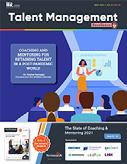



 Julie winkle giulioni Author, Virtual /Live Keynote Presenter, Inc.’s Top 100 Leadership Speakers
Julie winkle giulioni Author, Virtual /Live Keynote Presenter, Inc.’s Top 100 Leadership Speakers


I regularly read and contribute to Leadership Excellence and Talent Management Excellence. I use many of the articles I read to augment my own presentations and I often share the articles with my clients. They are always quick, right on target for the latest issues in my field, and appreciated by my clients. If you want to stay up to date on the latest HR trends, choose a few of the different issues from the Excellence series of publications.





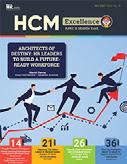
We’re eager to hear your feedback on our magazines. Let us know your thoughts at ePubEditors@hr.com
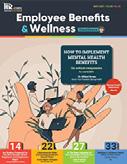

WHY EXCELLENCE PUBLICATIONS?
Dr. Beverly Kaye CEO, BevKaye&Co.
16 HR Management t ips For small Business owners

From creating a checklist to outsourcing HR, the list continues
By Brett Farmiloe, Terkel.io
From trying out the Porter Value Chain Model to offering training opportunities, 16 small business owners answer the question, “Can you share your most effective tips on how you successfully delegate HR tasks?”
● Use the Porter Value Chain Model
● Outsource HR When You Start to Grow
● Recognize and Appreciate Success
● Ensure Legal Compliance
● Find the Right Person for Each Task
● Approach from Every Angle
● Write Documentation
● Create a Checklist of HR Duties and Control It
● Summarize the Responsibilities
● Choose Someone With Excellent People Skills
● Provide Resources, Training, and Autonomy
● Leave Space for Two-way Feedback
● Hire an HR Leader as Early as Possible
● Be Clear and Specific With Your Expectations
● Find Partners and Services that You Trust
● Give Generous Opportunities When Training People
Submit Your Articles HR Strategy & Planning Excellence presented by HR.com February 2023 7
CoVeR aRtiCle
use the porter Value Chain Model
A great way to delegate is to focus on creating specific roles or job descriptions within the organization, based on the skill level required. An uncommon technique for achieving this goal is using the Porter Value Chain model as a reference framework.
This can help small businesses isolate their core areas of activity, allowing them to clearly delineate which tasks are more suitable for certain employees, and enabling them to delegate responsibilities accordingly.
Additionally, it’s important for business owners to communicate expectations transparently, maintain open communication lines with employees, and provide adequate training as necessary.
outsource HR when You grow
I have a small business with around 20 employees. I had been doing HR myself for the last 14 years, but with more employees, it was taking too much of my time.
Paychex is helping us outsource some of our HR projects. We had been using Paychex for payroll for years and decided it would be easy to implement since they are already similar to our business. We are not big enough to hire our own full-time HR employee, so outsourcing is a great option for us.
With outsourcing HR, I could pick which features I wanted to handle myself and which features Paychex would handle. The best part is now my employees can go directly to Paychex with questions and free me up to do the role of a CEO.
Tasia Duske, CEO, Museum Hack

Recognize and appreciate success
Evan McCarthy, President & CEO, SportingSmiles
So, you’ve cautiously delegated an HR responsibility that you’ve been handling on your own for years. You’re already mentally preparing yourself for the inevitable letdown since you know no one will replicate your success.
Then, Joe Bloggs comes along and plays a blinder, finishing the job faster and more efficiently than you ever could have. Don’t let any of this ruffle your feathers. You got it; this is proper delegation.
Joe deserves your thanks and recognition for his hard work, so be sure to tell him how crucial his efforts were to the success of your company. Joe is far more likely to maintain his high standards if he is encouraged by the knowledge that his efforts are recognized and appreciated.
 Edward Mellett, Co-Founder, Wikijob
Edward Mellett, Co-Founder, Wikijob

Submit Your Articles HR Strategy & Planning Excellence presented by HR.com February 2023 8
16 HR Management Tips For Small Business Owners
ensure legal Compliance
Ensuring compliance with labor laws is a crucial aspect of HR, and small businesses can delegate this task to an HR consultant or attorney. These professionals stay up-to-date with changes in labor laws and can advise the business on compliance with laws such as minimum wage, overtime pay, equal employment opportunity, and anti-discrimination laws.
By delegating this task, small businesses can reduce the risk of legal penalties and create a fair and equitable workplace for employees.
approach from every angle
As a small agency, we’ve run our HR side of things a few different ways over the years. For a while, it made sense to outsource to an HR agency that could support us with their experience on an as-needed basis while we grew the business.
Mark Pierce, CEO, Cloud Peak Law Group
Find the Right person for each task
When handing over HR tasks, it’s important to choose the right person for each job. You may have some experts in certain areas on your team and not even know it. One way to ensure the best person is matched for the task is to look a little further into your team members’ backgrounds and interests and see who might have the skills and experience they can apply to a new role.
Alternatively, have a team meeting and find out who might be interested in taking on certain tasks; the level of interest you get may surprise you. Employees understand that being assigned meaningful and challenging tasks can be a great opportunity to develop their skills and increase their engagement. This way, you can align your employees’ skills and interests with the HR tasks you give them. You will feel much more confident handing over HR tasks when the right person is on the job.
Anthony Martin, Founder & CEO, Choice Mutual

Over time, we brought more of that work in-house. I hired a Chief Financial Officer to oversee some of that work, alongside our existing Chief Happiness Officer and bookkeeper. Recently, we brought in a full-time HR professional with over 20 years of experience. So, we delegate HR tasks between several team members looking at it from different angles-employee advocacy, company culture, finances, and so on. That way, we have a rounded team.
Matthew Stibbe, CEO, Articulate Marketing


write Documentation
Creating extensive written documentation is the most important piece for successfully delegating HR tasks, whether to a dedicated HR pro or across multiple people on your team. There is a lot to get right with HR, and mistakes can be expensive in terms of both actual cost and employee goodwill. Documentation is the only way to ensure that everybody understands the same thing, and the only way you can hold your team accountable for doing something the right way, every time.
Gordana Sretenovic, Co-Founder, Workello

Submit Your Articles HR Strategy & Planning Excellence presented by HR.com February 2023 9
16 HR Management Tips For Small Business Owners
Create a Checklist of HR Duties and Control it
With our remote workforce, it is crucial to delegate HR tasks effectively in order to keep our employees satisfied and our business running smoothly. To ensure that tasks are being completed in a timely and accurate manner, I recommend creating a checklist of HR duties to be completed each week.
Once the checklist is created, I recommend assigning each task to a specific person. This will ensure that you hold each person accountable for their assigned tasks and will also allow you to track who is completing the tasks and how quickly they are being completed.
Finally, it is important to set strict deadlines for each task so that the work gets done in a timely manner. By following these simple steps, you will delegate HR tasks successfully and keep your business running smoothly.
Luciano Colos, Founder & CEO, PitchGrade

summarize the Responsibilities
It’s important to communicate to the person you’re delegating to what the purpose of the task is, and how it fits in with the overall goals of the business. It can be easy when delegating to explain tasks focusing myopically on the individual steps that must be taken, but without an understanding of the intended outcome or how the task contributes to the success of the department or business, it can be difficult for the employee to grasp its importance.
Handing over tasks without context also stifles creativity and innovation, as the narrow focus on the task may limit the employee in thinking outside of the box. Therefore, it’s important to summarize why the task is important and what you want to get from it. Doing so will allow your employee to truly understand how their work is contributing to the success of your business, and to potentially think of new and better ways of getting the job done.
Ian Wright, Managing Director, Business Financing

Choose someone with excellent people skills
In a small business, you can delegate HR tasks to a capable team member. Choose someone with excellent people skills because they will deal with lots of people-handling tasks, including conflict resolution and delivering bad news.
When you find someone with the right soft skills, it is also important to train them formally for HR functions. That includes the technical stuff, such as ensuring that you comply with employment laws.
Aidan Kang, CEO, House of Debt

Submit Your Articles HR Strategy & Planning Excellence presented by HR.com February 2023 10
16 HR Management Tips For Small Business Owners
provide Resources, training, and autonomy
The best strategy to follow in this involves three important steps. First, make sure that the person you are delegating HR tasks to has access to enough resources that will allow them to actually do the job. There also needs to be proper training to ensure that this person has the skills and capabilities to get the job done.
Also, perhaps more importantly, there must be 100% autonomy in decision-making. Let the junior staff take a much more significant role in making hands-on decisions without always having to consult management. This makes the process more efficient and gives junior staff more responsibility at work.
leave space for two-way Feedback
To ensure your delegation process is as effective as possible, debrief with your team after previous tasks are complete. If there’s room for improvement, give constructive feedback that will help your team next time, but be sure to mention the positive feedback, too!
Ask your HR team for feedback on your delegation and communication skills. If something gets lost in translation because you were unclear, you can use employee feedback to improve for next time. Make space for that two-way communication and feedback, before, during, and post-delegation.
Tory Gray, CEO & Founder, The Gray Dot Company
 Logan Nguyen, Co-Founder, MIDSS
Logan Nguyen, Co-Founder, MIDSS

Hire an HR leader as early as possible
My best tip for delegating HR tasks is to bring in someone as a partner who is the de facto HR leader of the business early on. For many companies, especially SMBs and startups, HR is one of the last functions they look at. They feel like they need to get marketing, sales, and finance ready first, or they don’t have a proper business.

These companies can win by leveraging any outstanding HR tools for administrative HR activities that allow for minimal cost, infrastructure, fuss, and time. On top of bringing in somebody as a partner and using tools, I would ask what tasks we consider administrative and outsource versus what we want to keep in-house and build into a talent management or talent acquisition function.
Overall, the key is to hire that first person upfront whom you trust and look at them as a partner. Don’t look at them as the last hire or function that you stood up for. Instead, look at them as somebody who will help take your business from good to great.
Oz Rashid, Founder & CEO, MSH
Submit Your Articles HR Strategy & Planning Excellence presented by HR.com February 2023 11
16 HR Management Tips For Small Business Owners
Be Clear and Specific With Your Expectations
Provide the team member with all the information and tools needed to complete the task, check in regularly, and be available to answer questions. When delegating tasks, it is important to be specific so that the person you are delegating understands the tasks that need to be completed, when they need to be completed, and what resources they have to draw on to complete the tasks.
If the expected outcomes are not clear or if you did not clearly outline the project timeline, it can lead to confusion and delays in completing tasks. Being clear and specific when delegating HR tasks will help to ensure that there is a clear understanding of tasks that need to be completed and help ensure that projects are completed in a timely manner.
 Harman Singh, Director, Cyphere
Harman Singh, Director, Cyphere

Submit Your Articles HR Strategy & Planning Excellence presented by HR.com February 2023 12
16 HR Management Tips For Small Business Owners
Find partners and services that You trust
As a small business owner, I’m still taking on a lot of HR tasks. Fortunately, because of some outstanding technologically enabled solutions and partners we’ve hired to off-board important but time-consuming tasks, I’ve been able to deal less with HR-related initiatives.
The key to allowing myself to be hands-off is that we spent a lot of time upfront getting recommendations and vetting partners and services before agreeing to anything. Without understanding the full capabilities we were unlocking and building partnership agreements that delivered on our needs, that wouldn’t have been possible.
Dan Gray, CEO, Vendry


give generous opportunities when training people
Delegating means letting go of the control that you have over your business and giving it to other people, trusting that they will deliver and do what they’re supposed to do. As a CEO of a growing small business, one tip in delegating HR tasks successfully is to never train people with only half your energy and enthusiasm.
Train them generously and adequately and give abundant opportunities to grow and apply all their learning to their tasks. There will be that fear that after all the training and time you invested, they will leave the company, but it’s something you have to compromise on as a business owner. One way to prevent that from happening is to treat your employees right.
Daniel Petkevich, Founder & CEO, Fair Square

Submit Your Articles HR Strategy & Planning Excellence presented by HR.com February 2023 13
16 HR Management Tips For Small Business Owners
Brett Farmiloe is the Founder / CEO and currently the CHRO of Terkel.io Would you like to comment?
practical HR t ips For small Business owners
Hiring and retention best practices business owners can implement to build diverse teams and create an inclusive workplace
By Jessica Lambrecht, The Rise Journey
Small businesses make up 99.9% of U.S. companies, employing 46.4% of people across the country 1. These businesses face the same challenges as their larger counterparts: how to hire and retain the right people to build and sustain a prosperous business. While the impact of great employees on the business is clear, the impact of management’s HR practices on employees is often overlooked. And with labor ranking among the highest costs for businesses, accounting for upwards of 70% of spending 2 and costing approximately $4,700 for each new hire 3 , managing the employee experience is vitally important. Added to all of this is the impact of building a diverse team, engaging new generations, and fostering an inclusive workplace.
Managing the hiring and retention of talented employees is a large investment and no simple task. The employee experience encompasses everything from the moment a potential applicant views a job description all the way to someone leaving the company. The resources necessary (both internally and externally) to create equity and inclusion at every stage are often beyond the resources of small businesses. More often than not, these critical processes are informal, if they even exist.
Given current economic conditions and shifting market trends, getting the right people on your team and getting them to stay are two of the biggest challenges facing small—or any—businesses today. While you may not have the resources to do a complete overhaul of all of your HR practices, there are steps you can take today to make immediate improvements in your existing systems to increase the quality of your talent pipeline and create an inclusive workplace where employees will flourish.
getting people on Your team
Building a great team is often difficult under the best of circumstances. Casting a wide net, being transparent about role expectations, and maintaining good relationships throughout the process will ensure the right people apply and stay engaged with your company, even if they don’t get the job (this time around).
● Include a salary range
● Include a start date and other relevant details of the hiring process.
● Clearly and accurately describe the role’s responsibilities and expectations
Submit Your Articles HR Strategy & Planning Excellence presented by HR.com February 2023 14
top pick
● Check your language. Guides can be found here, here, and here
● Determine which specific work, education, and certification requirements are necessary. It is very common for employers to use boilerplate language, which often includes a college degree as a requirement. Generic requirements can greatly reduce the number of qualified applicants from applying.
● Clearly detail existing policies. Do you have PTO or parental leave policies?
● When choosing where to post the job, consider numerous channels to ensure you’re reaching a diverse audience
● Include any relevant details a potential applicant may need to know in order to apply. Is there a busy season, will there be on-call shifts?
● Ensure you’re in compliance with state and federal guidelines, including EEOC and ADA
● Standardizing the interview process is incredibly important. Determine the structure of the
process, create a scorecard, develop a set of questions, and train everyone involved in the process how to properly participate. There’s a lot of room for bias at this stage of the process; however, by standardizing each step and the interviewer’s feedback, you can take steps to ensure an equitable experience.
Keeping people on Your team
Engaging employees to encourage commitment and productivity is challenging for organizations of any size and spans so many aspects of the workplace experience that each company will need to understand and leverage its own unique strengths.

● Set employees up to succeed. Schedule ample time to:
● Train new employees in their roles and standard operating norms.
● Get individuals comfortable using the everyday platforms necessary to do the job. Do not assume everyone is familiar with Slack or a specific POS system.
Submit Your Articles HR Strategy & Planning Excellence presented by HR.com February 2023 15
Practical HR Tips For Small Business Owners
● Meet everyone on the team and get familiar with the structure of the company. At the very least, ensure new employees meet everyone they will report to or work with directly.
● Create a career plan from the start. Clarify the frameworks and expectations for advancement and bonus opportunities, and provide realistic, actionable goals. For folks just starting out, this can and should include goals around getting acquainted with their role and the company.
● Set regular check-ins for the first 30-90 days. This might start with daily 1:1s for the first two weeks, and taper to bi-weekly.
● Identify regular opportunities to recognize employees and acknowledge high performance, values-aligned behavior, and efforts made toward company goals, regardless of the outcome.
● Performance reviews should be regularly scheduled. These meetings should include sharing feedback, assessing progress toward goals, and if or when they are eligible for a promotion, raise, or bonus.
● If resources don’t allow for a raise or bonus, consider non-monetary rewards.
Beyond achieving immediate business goals, small businesses can create change in their communities and serve as pillars of their industries by developing
and implementing strong HR practices built on a foundation of diversity, equity, and inclusion. What’s best for employees is ultimately what’s best for business.


Notes
1. https://www.forbes.com/advisor/business/ small-business-statistics/
2. https://www.paycor.com/resource-center/articles/ closer-look-at-labor-costs/
3. https://www.shrm.org/resourcesandtools/hr-topics/talentacquisition/pages/the-real-costs-of-recruitment.aspx
Would you like to comment?
Submit Your Articles HR Strategy & Planning Excellence presented by HR.com February 2023 16
Jessica Lambrecht is the Co-Founder and CEO of The Rise Journey, an HR and Workplace Culture consulting firm, and recently launched a new membership platform One Person Human Resources, OPHR, to support small teams in their People Operations.
Practical HR Tips For Small Business Owners
workplace 3.0: How leaders should prepare For t he Newest Office evolution
By Brigette McInnis-Day, UiPath
Simply stated, a lot has changed in how we define work and our professional purpose in the past few years. Since the Covid-19 pandemic, offices have transformed into worldwide virtual spaces, and technology, like artificial intelligence and automation, has accelerated productivity and innovation. However, a new era of work is amongst us: Workplace 3.0, changing what we know about the workplace.
In a short time, technologies have moved from read-only (Workplace 1.0), to participatory (Workplace 2.0), and now employee agency of choice (Workplace 3.0). Similarly, what once was the new age of digital work has quickly transformed into another era of work, completely uprooting the way business is done for both employers and their employees.
In Workplace 3.0, employers strive for accelerated innovation and productivity as they cope with challenging hiring options. Meanwhile, employees are desperate for solutions that can help them tackle the pile-up of tasks they’re asked to do so they can focus on more meaningful work. These problems, although different on the surface, require the same solution: changing how we work with the help of transformative technology. Now, employers and
human resource experts have been given the perfect opportunity to prioritize the right technology and inspire a company-wide change driven by innovation and an understanding of this latest evolution.

today’s workplace Challenges
Problems in the workplace can affect everyone, from seasoned employees to new hires, no matter their level or position. But what many employers don’t realize is many of the most critical workplace issues are attributable to systemic factors embedded in organizational processes. Yet, they are typically only addressed on an individual level. So why do we keep investing in remedies with little chance of working?
Submit Your Articles HR Strategy & Planning Excellence presented by HR.com February 2023 17
transforming from status quo to supercharged
Issues like inadequate training, communication gaps, time management, misuse of resources, and a lack of collaboration can cause frustration, burnout, and lower rates of productivity across the workplace. Forty-three percent of US office workers feel burned out at work, according to a survey by Slack’s Future Forum, while data by Gallup shows that a third of all workers always or very often feel burned out at work.
Despite new innovations in the workplace, work itself hasn’t improved, and workloads are still too heavy for employees to manage. Many mundane tasks or one-to-many solutions are still done manually first, versus through an automation-first strategy that leverages resources in a more strategic way. While executives may be eager to return to how things were before the pandemic, that may never be possible.
In order to understand and fix these challenges, organizations must be ready to change the way they operate and work—embracing technology to uplift their employees and enter the age of Workplace 3.0.

transforming from status Quo to supercharged
Technology exists that can help bridge the gap between what employers need and what employees want—allowing the workplace to incorporate and accept the changes associated with Workplace 3.0. As HR professionals, we are at the perfect opportunity to be drivers of this change and transformation. With the right technology implemented, the workplace can transform into a place where everyone can feel supported, aiding in productivity and reducing stress and burnout. Technology like automation can take on routine tasks that take copious amounts of time and that everyone dreads doing, making digital transformation a reality.
Business automation software allows organizations, departments, and teams to build, deploy, and manage software robots that emulate human interactions with digital systems and software. Like people, software robots can do things like understand what’s on a screen, complete the right keystrokes, navigate systems, identify and extract data, and perform a wide range of defined actions. Software robots can do it faster and more consistently than people, increasing
productivity as they act as virtual assistants to those who want an extra hand performing mundane tasks. Automation is noninvasive and can be rapidly implemented alongside existing technology to accelerate digital transformation. It makes Workplace 3.0—this new era of working in which productivity increases with the help of automation and AI but also creates happier workers—a reality.
In this environment, software robots—instead of people—do repetitive and lower-value work, such as logging into applications and systems, moving files and folders, extracting, copying, and inserting data, filling in forms, and completing routine analyses and reports. Advanced robots can even perform cognitive processes, like interpreting text, engaging in chats and conversations, understanding unstructured data, and applying advanced machine learning models to make complex decisions.
For HR teams, software robots can reduce all the manual tasks related to time-consuming processes such as onboarding, payroll processing, compensation changes, or exit management—not only simplifying these tasks for themselves but for employees as well.
Adopting innovative technology will allow organizations to tackle any challenges and embrace this new era of work. Workplace 3.0 aims to empower both employers and their employees, creating a more meaningful and productive working environment. Understanding the challenges of the current way we work, and seeing where innovative technology like business automation can help, will inspire this change rooted in transformation. Adapting to a decentralized workforce rooted in technology is the core of Workplace 3.0, and organizations should embrace this evolution.
Would you like to comment?
Submit Your Articles HR Strategy & Planning Excellence presented by HR.com February 2023 18 Workplace 3.0: How Leaders Should Prepare For The Newest Office Evolution
Brigette McInnis-Day is Chief People Officer at UiPath.
Five trends t hat will shape HR in 2023

From distributed work to employee retention
By Jacky Turnbull, Topia
HR professionals have had to navigate a huge amount of change in workplace norms over the past few years. From the growth in distributed work and new compliance risks to a greater focus on diversity initiatives, to a renewed emphasis on optimizing HR tech, HR teams are under pressure to keep up with balancing internal and external challenges and knowing how to prioritize budgets and resources. As we enter 2023, here are a few of the top HR trends that are here to stay:
1. Distributed and remote work policies will become a more fundamental part of talent strategies
The growth in remote, distributed, and hybrid work has become one of the biggest workplace trends of the past few years. As employees have embraced the greater work location flexibility they experienced during the pandemic, HR professionals have had to change how their remote and distributed work policies are structured and managed. 85% of HR professionals
Submit Your Articles HR Strategy & Planning Excellence presented by HR.com February 2023 19
top pick
surveyed in Topia’s 2022 Adapt survey reported they expect remote work requests to increase. However, many companies have begun implementing returnto-office policies even while workers are continuing to demand flexibility. With the labor market remaining relatively tight and many employees planning to explore their options in 2023, - many doing so in search of more flexible conditions - retaining top talent is a top priority for HR professionals.
Meeting employee demand for flexible and remote work is not always easy, but implementing restrictive remote work policies could mean losing top talent. HR professionals hoping to increase retention in 2023 must make flexible and distributed work a key part of their overall strategy.
2. workplace diversity and inclusion initiatives will stay at the forefront
Workplace diversity, equity and inclusion (DE&I) are essential elements of a thriving company culture, not just because they empower employees to bring their full selves to work, but because diverse businesses outperform their less diverse counterparts. Previously,

many diversity initiatives focused primarily on recruiting. However, HR professionals need to continue to examine the entire employee lifecycle through a DE&I lens. In this holistic view of DE&I, HR professionals must give more thought to their onboarding, development, promotion and workplace flexibility practices to create a more inclusive work environment. Several large companies including Google, PwC, and Microsoft now publish an annual DE&I report. As a result, companies looking to keep up with these large, household names in terms of hiring will need to become more transparent about their DE&I practices and initiatives.
A focus on the flexible working arrangements outlined in trend #1 can also support DE&I efforts. Research tells us that offering connected work environments with greater flexibility in work location helps foster a sense of inclusion and belonging among marginalized workers. As an example, tech giant Facebook reported an increase in diverse hires since expanding its remote working options and another study showed that remote work enables higher employment levels among people with disabilities.
Submit Your Articles HR Strategy & Planning Excellence presented by HR.com February 2023 20
Five Trends That Will Shape HR In 2023
3. emerging compliance challenges around immigration, mobility, and distributed work will lead to more complexity for HR teams
Back in 2020, when employees were first propelled into remote work without notice, there was less monitoring of where employees were working from and what legal and tax implications came with distributed work. In 2023, with the peak of the Covid-19 pandemic now behind us, enforcement and audits of tax and immigration compliance are expected to rise as governments look to recover from significant financial shortfalls. While many businesses offer greater flexibility regarding remote and distributed work, that flexibility comes with greater risks that can create problems if not managed properly. Tax, immigration, social security and legal issues all come into play when managing a remote and distributed workforce. HR professionals need to be more mindful of their approach to compliance and ensure that they have the right technology and processes in place to manage this risk and ensure audit readiness in 2023.
4. HR leaders will need to continue to focus on employee experience to maximize retention

During the Great Resignation in 2021 and 2022, when employees were quitting at higher than usual rates and there was a surge in job openings, talent acquisition was the main priority for many HR professionals. With mounting economic uncertainty and high inflation in 2023, many companies have scaled back on acquisition and, in some cases, laid off employees. While there has been chatter about the pendulum swinging back to being an “employer’s market,” now is the time to double down on your existing team to retain top talent. It’s important to consider every aspect of the employee experience, especially at a time when monetary benefits may be more scarce. Employee expectations are changing, with 94% of employees believing that they should be able to work from anywhere as long as they get their work done. Listening to employees’ changing expectations and offering flexible benefits like remote work opportunities gives HR professionals a chance to invest in their existing team to retain top talent.
5. HR leaders will look to optimize their tech stack while keeping an eye on costs
In the current economic climate, businesses are understandably more conscious of costs and HR professionals across the globe will be tasked with doing more with less. HR leaders who are staying up to date with trends will be looking for cost-effective and scalable solutions to deliver on their 2023 HR strategies. This will involve looking at their team’s current tech stack and considering ways to review, replace, and optimize to maximize return on investment. As businesses strive to create more value for customers, they will want their teams to focus on high-value tasks. This may mean implementing software that can automate repetitive manual processes in global mobility, remote work, or immigration procedures to free their teams up to be able to focus on more strategic tasks.
The way we work has changed radically over the last few years and HR professionals have had to deal with the challenges created by the Covid-19 pandemic, a rise in remote and distributed work, and shifts in employee expectations. But 2023 will bring its own challenges in the form of high inflation, a cost-of-living crisis, and looming economic uncertainty. Nonetheless, companies will still need to provide flexible and inclusive employee experiences and take advantage of the benefits of the newly distributed workforce to remain ahead of the competition.
Submit Your Articles HR Strategy & Planning Excellence presented by HR.com February 2023 21
Five Trends That Will Shape HR In 2023
Jacky Turnbull, Chief People Officer at Topia Would you like to comment?
w hy should HR integrate l&D into t heir talent Management strategy?
never underestimate the value of retaining top talent
By Laura Baldwin, O'Reilly Media
Companies have hit particularly difficult economic times in the past year. In the midst of layoffs and massive budget restructures, it is challenging for HR executives to know where to prioritize their spending in 2023.
For those who want to experience continued employee retention and recruitment, I challenge you to place learning and development (L&D) at the heart of your talent management strategy. According to recent research, 70% of employees would consider leaving their current company for a role in an organization known for investing in employee development.
And 94% of employees would remain working for an organization that invested in career development. These numbers lead to only one conclusion: invest in your people’s professional development if you want to retain them.
If there is one thing I have learned in my time as a business leader and former CFO, it is that you can never underestimate the value of retaining top talent. Not only are employees happier and more productive, but from a broader business perspective, talent retention is the difference between high and low-performing companies.
Because of its high value and scarcity, talent matters. If companies do not get this right, there are huge costs for replacing the right talent given the time, effort, and resources required.
Below are four ways HR managers can ensure L&D is effectively integrated into their talent management strategy.
1. incorporate l&D into Company Culture and Values
Learning culture starts from the top. It is crucial to communicate your learning initiatives to employees, then back these initiatives up with the resources your employees will need. The difference between companies that are able to survive the talent shortage and those that fail to remain competitive will come down to their ability to invest in the growth and development of their employees.
This includes empowering your teams with the tools and technologies they need to accomplish their daily tasks and responsibilities. Another important piece of this is providing them with opportunities to build new skills — whether it is by providing access to a learning platform, the ability to attend virtual industry conferences, or the chance to earn professional certifications.
Submit Your Articles HR Strategy & Planning Excellence presented by HR.com February 2023 22
Companies that make L&D synonymous with their corporate values will not only retain talent but also become more attractive to prospective job seekers. By creating a culture of learning, companies will further enhance their value to job seekers and naturally attract more talent over time.
However, it is imperative that job seekers see that your company does not simply pay lip service to learning and professional development. Companies must actively create opportunities to make professional growth happen for their employees.
2. Create Pathways for Collaboration
With the onset of the pandemic, many organizations turned to remote operations. However, the skills required for collaboration in a remote work environment are a bit different from those we used before the pandemic. Soft skills have become much more important. Expressing and sharing ideas involve a bit more written communication than they used to.
Forging relationships, establishing trust, and building camaraderie with coworkers all take more effort as well. Managers should provide pathways for their teams to develop these skills and practice outreach with coworkers, and give them the space to do so.

Going hand-in-hand with collaboration, providing opportunities for peer-to-peer learning is another important part of building a learning culture. By providing a dedicated space for team members to share ideas and reach out for help, information, and guidance, peer learning creates an engaged workforce that is encouraged to develop their skills since it is constantly reinforced in their workflow, if and when needed. Developing regular rhythms of collaboration among teams is also crucial in fostering better teamwork, cooperation, and team unity that is necessary to achieve shared business goals.
3. provide a Variety of learning Modalities
Not all learning is created equal. This means that every single person within your organization will not learn in the same way, or at the same pace. Incorporating a variety of learning modalities for employees is an important part of ensuring they are getting the professional advancement and training opportunities needed – and is key to getting talent management right.
For example, if an engineer is looking for a quick line of code to complete a project, pointing them in the direction of a 250-page ebook or a two-hour recorded
Submit Your Articles HR Strategy & Planning Excellence presented by HR.com February 2023 23
Why Should HR Integrate L&D Into Their Talent Management Strategy?
conference session probably is not helpful. But getting them straight to that needed line of code absolutely is.
However, if a software architect is preparing to move their organization from a monolith to a distributed system, a 250-page ebook about microservices could be exactly what is needed. That is why it is essential to provide individuals with multiple learning modalities — books, videos, interactive learning scenarios, live online courses, instant answers, and more — so they can apply what is appropriate for the task at hand.
4. incorporate Varying levels of Hands-on learning
Learning by doing is arguably the best way to develop a new skill. After all, you did not learn to ride a bike by reading about it. Beyond books and videos, providing interactive learning experiences will allow learners
to apply newfound knowledge immediately. For developers, this might include sandbox environments that allow them to experiment with technologies like Linux and SQL before putting them to work in the real world. These sandbox environments enable them to learn how they work and make mistakes in a safe environment that will not impact the business.
Not all situations will require such involved learning, however. When it comes to progressively building knowledge, more often than not, employees will simply need a quick answer to a problem. In these instances, AI-enabled L&D tools allow employees to quickly access the right resources in the flow of their day-to-day and eliminate the need to poor over chapters of a textbook. Whether providing quick access to answers or opportunities to try out new coding skills, providing varying levels of hands-on learning helps employees cement their knowledge and accomplish their work.

Placing learning at the center of talent management is imperative to recruit and retain top talent. Employees are demanding career development and, in today’s competitive job market, employers who meet this request will see talent flock in droves. Employers should no longer ask whether they can afford to incorporate L&D into their budget, but whether they can afford not to.
Laura Baldwin is the President of O’Reilly Media. Laura began working with O’Reilly in October 2001 as chief financial officer and added chief operating officer to her responsibilities in October 2004 before becoming the company’s first president in March 2011. She’s spent the years since focused on building and leading O’Reilly’s businesses worldwide. Prior to O’Reilly, she was a consultant to the publishing industry and managed several large consulting engagements across all genres of publishing and media.
Would you like to comment?

Submit Your Articles HR Strategy & Planning Excellence presented by HR.com February 2023 24
Why Should HR Integrate L&D Into Their Talent Management Strategy?
six HR transformations For 2023
what’s the wisest way to approach transformation?
By Jamie Aitken, Betterworks
Today’s organizations remain focused on digital transformation to enable “a digital-first business.” As part of that, the tools they use and skills necessary for success will change. Meanwhile, individual departments are undergoing their own transformations to improve operational efficiency and customer experience. One of the last departments to transform is HR because the traditional tools are familiar and, historically, HR processes have not changed much.
That inertia is becoming unacceptable as the pace of business continues to move toward real-time. More importantly, customers and employees expect HR to provide modern experiences irrespective of how much disruption it may cause to get there.
A best practice for HR transformation is the same as that for digital transformation: it’s best approached as an ongoing process, not an event.

Following are six HR transformations that will become more common in 2023:
#1: HR will Become More strategic
HR is rapidly moving from being operational to being strategic, which requires both business and financial acumen. More fundamentally, the CHRO needs to be an active member of the C-suite helping to realize business goals—not just HR goals. They must also understand the company’s risks, so they have a realistic view of how the business operates and why.
Submit Your Articles HR Strategy & Planning Excellence presented by HR.com February 2023 25
top pick
Traditional HR is also known to cause burnout because administrative work alone can be uninspiring. By transforming HR into a strategic asset, HR professionals can make a positive difference for their company, and their work is more challenging and exciting.
#2: HR leaders will Build a network to Help Facilitate transformation
For HR to become a more strategic asset of the business, HR leaders will need to build alliances across the organization and take advantage of internal expertise that can help them accelerate transformation projects. It’s also necessary to leverage information silos with data-sharing capabilities that improve cross-functional efficiency.

Soft skills are always necessary for HR, but they need to be used outside the department since every project will require alignment, support, and investment.
#3: More HR professionals will use Design thinking
Many HR professionals don’t know what they don’t know, and one of those unknowns is how to understand the organization’s intended future state,
because everything, including HR practices and technology, needs to align with it. Not surprisingly, a lot of HR professionals struggle when designing a future state, so they often pull in consultants to help.
I use design thinking to create a future state because the process allows me to understand a problem from the stakeholders’ points of view. According to the MIT Sloan School of Business, there are four steps to design thinking:
● Understand the problem
● Develop possible solutions
● Prototype, test and refine
● Implement
I find this process helpful because it fosters greater creativity and encourages brainstorming. It also allows me to understand the implications of any digital transformation that might be happening within the organization, including HR transformation.
#4: CHRos will strengthen ties with the CFo
CHROs will actively pursue deeper relationships with their company’s CFO to sharpen their business and
Submit Your Articles HR Strategy & Planning Excellence presented by HR.com February 2023 26
Six HR Transformations For 2023
financial acumen. It can take a bit of courage to ask for assistance in the first place, but the payoff is well worth it. Having the CFO in your corner can open your eyes to dynamics occurring in the company, among customers and in the industry that you may not have considered.
#5: HR transformation pressure will Rise

HR can sometimes be risk averse as if it ain’t broke, why fix it? The most important reason to modernize HR is that the traditional business as usual tends not to align with the company’s more digital future state.
Companies have realized that becoming digital-first is no longer an option, so there’s a tremendous focus on that. It’s time-consuming and expensive, but it’s what customers and employees expect.
That digital-first mindset also applies to HR and is forcing HR transformation to the forefront.
For one thing, Millennials and Gen Z were born into a world that is more digital than their predecessors. Since technology is part of the younger generations’ DNA, they expect internal systems to be intuitive. They also have different preferences when it comes to compensation packages and perks.
These young and middle-aged professionals tend to surround themselves with technology in their personal lives, which is why they expect their employers’ software to operate as easily as Google. They’re also more likely to customize an app because they think the software should adapt to them versus the other way around.
The most mature organizations realize all this, and they’ve put HR technology in place to facilitate transformation. Because they were early adopters, they’re already familiar with modern software and how it differs from traditional tools. And, because they’re using intelligent automation to automate rote tasks, they have more time to innovate.
#6: Change Management will Be essential
Every time a business changes the way it operates, a fair number of employees may not be on board
because there was no change management process in place. According to Gartner’s Workforce Change Survey, 74% of employees were willing to change work behaviors to support organizational changes in 2016, but that number dropped to 38% in 2022.
Effective change management involves “customers” (stakeholders) from the beginning because individuals are more likely to participate in a program or practice that they helped design versus one that was forced upon them.
Some companies have appointed project managers in their HR departments who are change management certified. However, the flip side is that not enough HR professionals are practicing or getting certified in change management skills.
Bottom line
The dynamics of business constantly change as a result of many factors: a shifting competitive landscape, technological innovation and changing customer and employee expectations. To keep pace, HR must transform, and the wisest way to approach transformation is to map the current and future states of the company and adjust HR operations accordingly.
Submit Your Articles HR Strategy & Planning Excellence presented by HR.com February 2023 27
Six HR Transformations For 2023
Jamie Aitken is VP of HR Transformation at Betterworks. Would you like to comment?
HRCI® & SHRM® CERTIFICATION PREP COURSES
GROUP RATES AVAILABLE
For HR Professionals
Show that management values the importance of the HR function, and has a commitment to development and improvement of HR staff.
Ensure that each person in your HR department has a standard and consistent understanding of policies, procedures, and regulations.
Place your HR team in a certification program as a rewarding team building achievement.
For Your Organization
Certified HR professionals help companies avoid risk by understanding compliance, laws, and regulations to properly manage your workforce.
HR Professionals lead employee engagement and development programs saving the company money through lower turnover and greater productivity and engagement.
A skilled HR professional can track important KPIs for the organization to make a major impact on strategic decisions and objectives, including: succession planning, staffing, and forecasting.
HR.com/prepcourse CALL TODAY TO FIND OUT MORE 1.877.472.6648 ext. 3 | sales@hr.com
1 Less expensive than a masters or PhD program, and very manageable to prepare with
2. legislation and best practices
3. Recognized, Industry benchmark, held by 500,000+ HR Professionals
Group Rate Options
We offer group rates for teams of 5+ or more for our regularly scheduled PHR/SPHR/ SHRM or aPHR courses.
For groups of 12+, we can design a more customized experience that meets your overall length of the course.
Groups rates for HRCI exams are also available as an add-on.
All group purchases come with 1 year of HR Prime membership for each attendee to gain the tools and updates needed to stay informed and compliant

CALL TODAY TO FIND OUT MORE 1.877.472.6648 ext. 3 | sales@hr.com | HR.com/prepcourse
1 2 3
w hat Meeting Data tells us about Hybrid work Culture
implementing “meeting-free” days has been successful for many organizations
By Mike Tolliver, Vyopta
Vyopta analyzed over 48 million meetings held in 2020, 2021, and 2022 by enterprise knowledge workers on virtual meeting platforms (Microsoft Teams, Webex, Zoom, and others). This data helped identify emerging trends in hybrid work culture over the past three years. These trends offer novel insight into the factors affecting effective hybrid collaboration.
The periods comprise three 6-week snapshots of time from 2020, 2021, and 2022, each from early April to mid-May. The approach of taking snapshots was chosen to better understand the changes in collaboration patterns across 2+ years of data.
We identified meaningful trends in how employees adjusted their collaboration habits over time and adapted to the challenges of remote work. We highlight four of those trends in this paper, including the significant increase in one-on-one meetings, the rise of ad-hoc collaboration, and changes in meeting attendance culture
The results have implications for employee wellness, productivity, retention, and effective organizational communication. Understanding these trends can empower organizational leaders to meet the needs of their workforce and improve the employee experience.

Submit Your Articles HR Strategy & Planning Excellence presented by HR.com February 2023 30
With the onset of the Covid-19 pandemic, nearly all meetings went virtual, almost overnight. This led to a similar proportional increase in concrete data.
This article extends that effort to measure engagement trends over time and studies how the workforce is adapting to remote-first and hybrid collaboration. Vyopta compared samples of meeting data from six-week periods from 2020, 2021, and 2022, and has found the following clear trends:
● An increase in meeting volume is propelled by a significant increase in ad hoc one-on-one (1:1) meetings, indicating a shift in how employees are using the technology and engaging with each other.

● Returning to the office (mostly in hybrid schedules) does not significantly impact the number of meetings held virtually.
● Meeting culture and familiarity with the technology both improved (17% fewer participants arriving late and 57% reduction in rejoins)
increased Meetings, More Meetings, less Focus
● The number of meetings per week for the average knowledge worker increased between each sample period while the average meeting
duration decreased (See Figure A). This is a continuation of previously published trends.
● However, the average number of participants decreased, reversing the prior trend noted early in the pandemic. –The number of participants in meetings increased (Microsoft)
An increased number of short meetings may support team dynamics in a remote/hybrid environment.
However, this also typically results in a more fragmented daily schedule for knowledge workers. This is an unintentional side effect and can easily go unnoticed, but the availability of sufficient focus time and the cost of interruptions should be monitored, especially since both factors are frequently cited as stressors that reduce wellness and productivity.

The drop in the average number of participants is mostly driven by the increase in 1:1 meetings which will be discussed later. However, both small-group and large-group meetings also saw reductions in participant size, just of a smaller magnitude.
Leaders can monitor how meeting schedules impact focus time and adjust recurring meetings as needed. Implementing “meeting-free” days has been successful for many organizations (Harvard Business Review). Encouraging employees to reserve focus time on their calendars is also important, but most of the burden falls on managers & team leads to be cognizant of focus time when scheduling recurring meetings
Would you like to comment?
Submit Your Articles HR Strategy & Planning Excellence presented by HR.com February 2023 31 What Meeting Data Tells Us About Hybrid Work Culture
Mike Tolliver is Product Management Director at Vyopta.
t he Future of HR is Being Forged now
By John Doel, KPMG LLP
Evenin the face of cooling wage pressure and rising unemployment, the talent shortage rages on. Human resources (HR) executives are struggling with the dual challenges of a job seeker’s market and structural labor problems that promise to last for years if not decades.
Among other factors, the Great Reconsideration is driving historical highs in the ratio of job openings to job seekers. Although there has been some improvement since last year when there were two open jobs for every worker, the country is still quite a distance from the one-to-one ratio needed to align labor demand with supply. At the same time, there is compelling evidence that the labor pool is shrinking.
(See sidebar)
Workers today are demanding remote working opportunities; learning paths and career growth; competitive compensation and benefits; and, perhaps above all, a sense of meaning and purpose in their work.
If their employers fall short, many – particularly in the younger demographic – are looking elsewhere.
HR functions have to stay one step ahead of these challenges to attract, retain, and provide compelling reasons to consider their organizations. According to our recent Future of HR survey of 300 Chief Human Resources Officers (CHROs), 61 percent say they need to remain flexible with their Employee Value Propositions (EVPs) to the external labor market.
talent shortages are not a passing challenge
● In the wake of stagnant labor force growth between February 2020 and December 2022,1 workforce participation is expected to increase only 0.5 percent annually between 2021 and 2031, according to the Bureau of Labor Statistics.2
● More than two million of the 3.5 million workers who have left the labor market are retirees, particularly Baby Boomers, according to the Federal Reserve Board.3 Considered alongside the fact that there are 1.5 million fewer prime-age workers than expected prior to the pandemic, a significant swath of the labor pool is unrecoverable.
● Women’s labor force participation in the U.S. hasn’t fully rebounded from the pandemic, which was women’s lowest participation point in the past 30 years. 4
Submit Your Articles HR Strategy & Planning Excellence presented by HR.com February 2023 32
KPMG Economics and Bureau of Labor Statistics
KPMG Economics
KPMG Economics
KPMG Economics
Sources: 1.
2.
3.
4.
top pick
HR leaders can help their companies move past the flux of the pandemic to a future of genuine flow
In addition to the EVP, our survey uncovered six key themes on which CHROs expect to focus over the next two years (click here to read the full survey report). In this article, we provide insights on three of them -building talent marketplaces to support agile growth, integrating digital technologies to enhance the HR function and the employee experience, and making the organization’s purpose real.
the talent Marketplace: a Fresh approach to workforce shaping
HR professionals are realizing that the historical paradigm of matching people to jobs is giving way to models centered on aligning skills with tasks. Many are experimenting with talent marketplaces, which involve comprehensive datasets of the organization’s people and their capabilities, linked to an understanding of where and when those skills are needed across the organization. The skills-first approach underpinning this model is being embraced by 46 percent of CHRO respondents to our survey.
One example of a company that has been an early adopter of the talent-marketplace model is the biotechnology company Genentech. Genentech is one of the companies with an HR leader who we view
as a “pathfinder” who takes innovative approaches to emerging challenges. The company’s need for agility in the current economy led them to begin fluidly assigning people with the right skills to projects –which they call “gigs.”
In tandem with the talent-marketplace model, future-oriented HR practices are elevating learning and development to the same level as policies and compensation. Remote and hybrid work models have largely erased ad-hoc learning and, to some degree, human-to-human collaboration. This has increased the need for CHROs to advocate for targeted career development activities that will ultimately enrich the talent marketplace, as employees pursue career paths even within a more transactional model.
the Digital HR Function: a Means to a Better employee experience
Given the competitive labor market, HR professionals recognize that legacy technology solutions and processes can be off-putting to today’s employees and prospects. Therefore, they prioritize creating consumer-grade, seamless working environments that are tailored to employees and driven by data and the latest digital technologies. Thirty-nine percent of

Submit Your Articles HR Strategy & Planning Excellence presented by HR.com February 2023 33
The Future Of HR Is Being Forged Now
CHRO respondents to our survey said digitalization was a top area of focus for the next three years.
Over the past two years, many technology investments were made reactively to facilitate remote work. However, many of these solutions had a relatively small impact on productivity and employee experience. Companies are now shifting to a more strategic mode and intentionally building upon this foundation to get more value from advanced technologies. Digitally driven workplaces allow for automation of administrative tasks; seamless integration of information across platforms; predictive staffing analytics; and people analytics to better understand the employee experience.
The good news is that 39 percent of CHRO respondents to our survey said digitalization was a top area of focus for the next three years. Although this commitment is encouraging, it is worth noting that only 10 percent said they can deliver on this imperative today. Clearly, there is work to be done.
the purpose-Driven organization: a Key Commitment for attracting talent

Forward-thinking HR leaders are committed to organizational purpose. They engage their employees in environmental, social, and governance (ESG) programs, including net-zero strategies and robust diversity equity and inclusion (DEI) programs.
Although 60 percent of the respondents to our recent CEO Outlook Survey say they are considering pulling back on ESG and DEI commitments during the economic downturn, faltering on these pledges could exacerbate the talent shortage. Younger workers view sustainable DEI and ESG programs as non-negotiable aspects of the Employee Value Proposition (EVP).
In this regard, HR leaders are functioning as marketers – ensuring that the employment brand remains strong and advertising the “why join this firm” value proposition. Encouragingly, 57 percent of CHRO respondents to our survey said ESG and DEI would remain top areas of focus for the next three years.
Electric truck company Tevva imbues its purpose in the fabric of the organization. The company hopes to expand its net-zero aspirations beyond its own trucks by working with suppliers and customers on more environmentally friendly ways to package and transport their materials. The company’s HR function, led by another pathfinder, is at the forefront of these efforts, ensuring that job candidates align with the company’s mission and holding managers to a high standard in terms of evangelizing the purpose and making decisions that align with the company’s values.
Conclusion
In a time when staffing shortages and the Great Reconsideration are making it more difficult than ever to attract, recruit, and retain employees, HR leaders have a critical role to play in ensuring the right talent is in place to bring their companies into the future. They can encourage senior leaders to support new models of workforce shaping like the talent marketplace. They can guide their organizations in the integration of digital technologies that enhance HR effectiveness and employee experience. And they can play a key role in ensuring that the company’s purpose is “real” and meaningful to employees. These and other progressive initiatives will help HR professionals guide their organizations from flux to a state of genuine flow.
Would you like to comment?
Submit Your Articles HR Strategy & Planning Excellence presented by HR.com February 2023 34
John Doel is the Human Capital Advisory Principal at KPMG LLP
The Future Of HR Is Being Forged Now

Submit Your Articles HR Strategy & Planning Excellence presented by HR.com February 2023 35 epublication editorialCalendar2023 Checkoutthenewandupcoming themedHRtopicsinHRStrategy& PlanningExcellence. Check ePublications Editorial Calendar Here. Would you like to submit an article? | Write to us at ePubEditors@hr.com Submission Guidelines 1 The Next Wave of Automation at Work/ Ethical AI and Blockchain Mar 2023 2 Metaverse and the Future of Work Apr 2023 3 The Future of HR's Role in Organizational Success May 2023 4 HR Tech: What’s New and What’s Ahead June 2023
Major trends impacting people Management in 2023
the best people operations teams in the world run like product management functions
By Finn Bartram, People Managing People
Thepast couple of years have tested HR leaders following the aftereffects of Covid-19. With an abrupt shift to remote work, mass resignations, and economic volatility, they were challenged across the board.
As HR teams continue prioritizing and adapting to challenges while keeping organizations functioning at their best, many of the knock-on effects on people management will continue into 2023.
So, what will be the major trends impacting people management in the months ahead as businesses settle into new ways of working, face fresh challenges, and zone in on new focuses?
New Working Norms
During the pandemic, entire industries shifted to remote work without a measurable loss in productivity – with many claiming
the era of ‘office work’ was forever over.
This is highlighted following a recent report showing almost 9 in 10 people would work flexibly if they were presented with an opportunity to.
But since companies called their workers back into the office in 2022, many did so with allowances.
Companies started to realize that employees want greater flexibility by working from home, so have switched to a hybrid model. Balancing the benefits of in-person and remote ways of working, others have decided to go fully remote or issued staff with strict return-to-office orders.
In addition to where we work, there has also been a quieter revolution unfolding when it
comes to how much time we spend working. Numerous 4-day working week trials have been taking place around the world, promising no loss of pay. And the results are positive.
The International study, where most participants were in the U.S. and Ireland, included 33 companies with 1,000 workers agreeing to a six-month trial of a 4-day working week. The companies stated revenue rose over the course of the trial, sick days and absenteeism were down and resignations fell slightly.
Stress, burnout, fatigue, and work-family conflict all declined, while physical and mental health, and work-life balance increased.
As we continue in 2032, business leaders and HR teams will have to work hard to evolve their working practices to determine which is best for them in the long term.
Submit Your Articles HR Strategy & Planning Excellence presented by HR.com February 2023 36
Getting feedback from employees will be integral to its success, as well as having the data to defend why.
Financial Coping Strategies
As recession winds continue to swirl amid layoffs and hiring freezes, both employees and employers are bracing for an uncertain future.
Organizations are grappling with understanding the new normal. As with any downturn, department leads will be asked to move their focus away from growth and instead toward profitability and cash flow.

Business resilience really has never been more critical and
companies will look towards HR professionals to play a leading role in supporting the workforce through this challenging period.
Employees are a company’s biggest asset and therefore highest cost. Looking at internal data, key performing indicators (KPIs), or productivity stats will be beneficial to make the business case for roles or individuals under review.
But keeping top talent will pay dividends as they could be the pillars needed to successfully ride out the economic storm.
However, workers are dealing with the rising costs of living, soaring energy bills, and high inflation. This worry translates
into pressure on salary increases by employees seeking to offset the increasing cost of living.
But faced with pay freezes, redundancies, and budget cuts, companies will be fearful valued employees might be at risk of leaving due to salary requests being denied.
If a salary increase isn’t on the cards, organizations can look at alternative incentives such as a four-day work week, training courses, or qualifications if there’s pressure on fixed costs.
There will also be an emphasis on including a financial well-being policy that feeds into an organization’s wider well-being strategy. Companies can look to
Submit Your Articles HR Strategy & Planning Excellence presented by HR.com February 2023 37
Major Trends Impacting People Management In 2023
see if action should be taken at a group or individual level, showing their commitment to supporting employees with their finances and reaffirming the benefits on offer that can assist.
“Back to Human”
Covid-19 accelerated employee demands on HR to meet physical and mental health needs. This urgency unveiled to the majority of businesses that some core human element has been lost in all these technological advancements.
For years, HR leaders have found themselves on a cost-efficiency treadmill that applies analytics and big data to existing HR operating models. Even in areas of HR like recruitment and learning and development, the emphasis has been on productivity and how to measure it.
However, businesses are remembering they’re dealing with real people, not machines. So, the ‘human’ element in HR has a renewed focus that will continue in 2023.
In a technology-first world, organizations that understand and look after their workforces on a human level will have a competitive advantage over those who don’t.
Drivers of positive behavior such as gratitude, trust, empathy and listening will continue to be prioritized, to ensure individuals stay and succeed. A sharp focus on employee health and well-being will also prevail, with preventative
care and personalized programs coming to the fore.
Companies will rethink the employee experience in ways that respect individual differences. They will look to implement more flexible, responsive policies: engaging more directly and deeply with employees, letting them bring their whole person to work.
A human-centric approach to people management will underpin the progression of diversity, equity, and inclusion (DEI) strategies.
Breaking DEI into smaller chunks of learning, communication and experiences threaded over time creates a more lasting impact. But to move the needle on DEI within an organization, DEI must receive the same level of investment as other critical strategies.
This includes a dedicated budget, a team, committee, or collaborators, leadership buy-in, and access to tools and data, such as applicant tracking software (ATS).
pops
A new interpretation of people ops is emerging, one that treats the employee experience as a “product” and something that’s integral to the business achieving its core mission or objective.

It’s a people-centric approach that focuses on what people experience as employees within the company to improve their productivity, growth, and satisfaction.
It includes all aspects of an employee’s life cycle, from recruitment and selection, performance management and professional development, and succession planning to resignation.
And managing this effectively comes down to a business approach to people ops.
The best people operations teams in the world run like product management functions. In this way, they can help organizations identify and attract the best talent, develop and retain their employees and create a positive work environment.
This concept may not be new, with Google being among one of the first to rebrand its HR department as ‘people operations’ back in 2006, but we can expect to see more organizations adopt this model to unlock greater productivity and solve people-orientated challenges faster in 2023.
Submit Your Articles HR Strategy & Planning Excellence presented by HR.com February 2023 38
Would you like to comment?
Finn Bartram is Editor in Chief at People Managing People.
Major Trends Impacting People Management In 2023
The Future of Diversity, Equity, Inclusion and Belonging March 15-16, 2023 RegisteR INSPIREHR WEST EMPOWERHR TECH AMERICAS 2023 March 6-8, 2023 RegisteR The State of Financial Wellness March 1, 2023 RegisteR Surviving or Thriving: Supporting Wellbeing in Hybrid Working Environments March 16, 2023 12:00 PM - 1:00 PM ET RegisteR Pathways to International Hiring Success: How to Find and Hire Top Talent in Any Country February 28, 2023 12:00 PM - 1:00 PM ET RegisteR ViRtual eVents & HR.CoM weBCasts upCoMing www.hr.com/upcoming_webcasts www.hr.com/virtualconferences View our Upcoming Webcasts Schedule and Register Today! we BC asts Ultimate Guide to Choosing a Cloud HR System March 9, 2023 2:00 PM - 3:00 PM ET RegisteR How to Prepare Your Employees for an Economic Slowdown March 1, 2023 11:00 AM - 12:00 PM ET RegisteR Are You Ready for Third Wave DEI? March 15, 2023 11:00 AM - 12:00 PM ET RegisteR we BC asts V i R tual e V ents View our Upcoming Virtual Conference Schedule and Register Today!
Thank you for partnering with us!
THANK YOU
Paychex, Inc. (Nasdaq: PAYX) is a leading provider of integrated human capital management software solutions for human resources, payroll, benefits, and insurance services.



LEARN MORE
Paycom (NYSE:PAYC) offers cloud-based human capital management software to help businesses streamline employment processes, from recruitment to retirement. With a robust suite of products including payroll, time and labor management.
LEARN MORE
Providing best-in-class consulting, rigorous analytics, and datadriven insights that help organizations make factbased decisions.
LEARN MORE
Sage enables organizations to thrive in today's digital world with AI-powered financials, planning, analytics, and HR solutions.

Designing better ways to work by providing cutting-edge products and exceptional experiences within HR, Talent, Time Management, Benefits and Payroll.

LEARN MORE
LEARN MORE
PARTNER WITH US




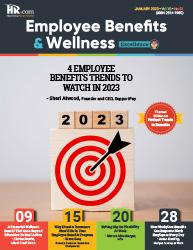





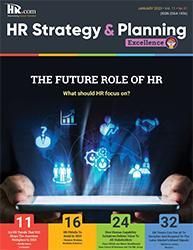
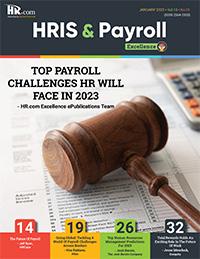

Like to submit an article? Use our online submission form or for more information go to www.hr.com/ExcellencePublications Publications 13 targeted publications to Reach Your audience Informing, Educating, Enlightening and Assisting HR professionals in their personal and professional development, the Excellence series offers high-quality content through the publications!


For more information: Phone: 1.877.472.6648 | Email: ePubeditors@hr.com | www.HR.com/epubs HR Strategy & Planning Excellence February 2023






 - John Doel, Advisory Principal, KPMG LLP
- John Doel, Advisory Principal, KPMG LLP










 Julie winkle giulioni Author, Virtual /Live Keynote Presenter, Inc.’s Top 100 Leadership Speakers
Julie winkle giulioni Author, Virtual /Live Keynote Presenter, Inc.’s Top 100 Leadership Speakers












 Edward Mellett, Co-Founder, Wikijob
Edward Mellett, Co-Founder, Wikijob








 Logan Nguyen, Co-Founder, MIDSS
Logan Nguyen, Co-Founder, MIDSS


 Harman Singh, Director, Cyphere
Harman Singh, Director, Cyphere













































